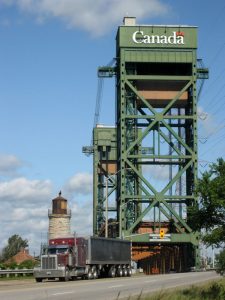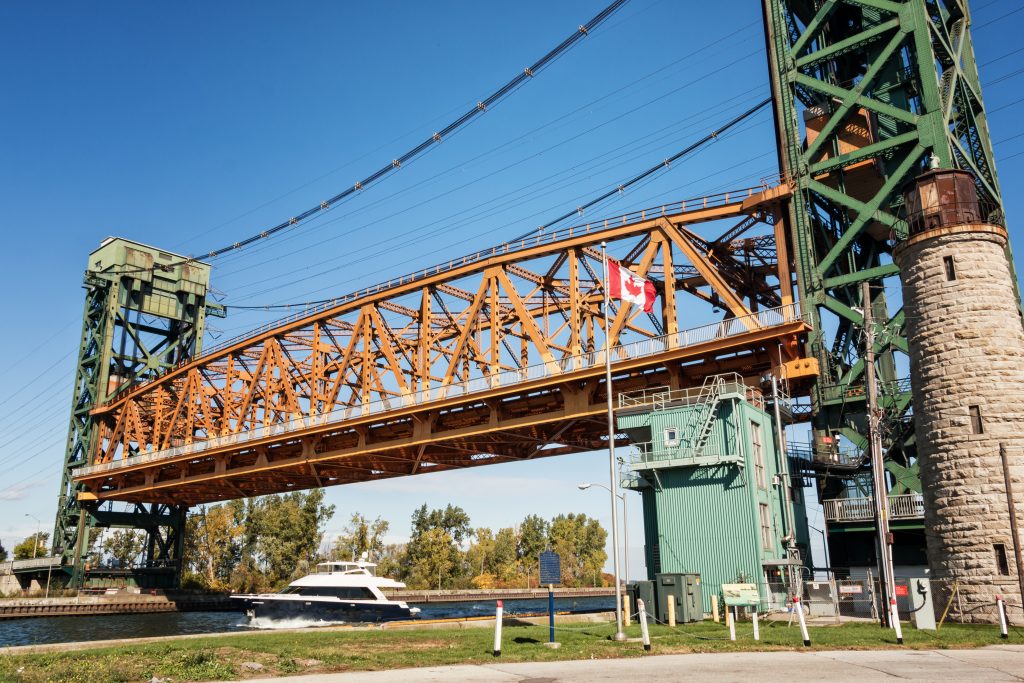The first phase of a $21-million overhaul of the iconic Burlington Canal Lift Bridge is well underway and expected to extend the life of the span by another five decades.
Iron workers, with support from specialized paint crews, are presently cutting the deck of the metal structure, along Eastport Drive between Hamilton Harbour and Lake Ontario, into chunks, removing the pieces one by one and replacing them. The work is tricky, as the bridge has been reduced to one lane for alternating traffic and is still being lifted when large boats need to pass underneath.
Work has also begun on widening sections of sidewalk and rehabilitation of the approach spans at the north and south ends of the bridge.
In January, the bridge will be closed to vehicles, pedestrians, and cyclists for three months to allow for the completion of the bridge deck replacement.
“The Burlington Canal Lift Bridge is an important asset for the community. The construction work on the bridge is a vital step to extend the life of the bridge and ensure that it continues to serve both local and national transportation needs,” says a statement prepared for Daily Commercial News by Public Services and Procurement Canada (PSPC) with input from the project team that is working on the venture.
The 116-metre-long bridge located on the western shore of Lake Ontario was opened in 1962 and connects the Hamilton Harbour industrial region to critical shipping lanes that lead to the Atlantic Ocean. Bridges spanning the canal date back to 1826. Since then, there have been five different moveable bridges.
The present structure originally had tracks for the Hamilton Northwestern Railway, but they were removed in 1982 when the roadway was widened to four lanes, allowing two lanes of traffic to flow in each direction.
The 1,996-tonne span is a tower-driven, vertical lift and moveable bridge. It was the largest and heaviest of its kind in Canada when it opened. The tower system uses sheaves and wire ropes to raise and lower the deck.
The bridge operates during the navigation season from mid-March to late December and is lifted for large vessels and pleasure craft.
On average, 25,000 vehicles cross the bridge each day. During the peak seasons, nearly 3,000 pedestrians and cyclists travel along the Beachway in Burlington daily, many of them using the canal lift bridge.
AECOM was awarded a $1.86-million contract to develop the design for the new bridge. A joint venture of EllisDon Civil Ltd. and Chant Ltd. is the construction manager.
“Currently, crews are removing the existing lift span deck grating and supporting steel stringers,” says the PSPC. “The work entails cutting the deck into manageable pieces and removing it. Once the deck is removed, the floor beams can be repaired, and the new deck installed.”

The lift span deck is being replaced in pieces to ensure that the bridge remains open to vehicular and pedestrian traffic and can continue to be raised to allow for marine passage until the beginning of January 2024.
“All the existing decking and stringers are made of steel and are being replaced with steel decking and stringers,” says the PSPC. “Approximately 500,000 pounds of steel is being removed and replaced on the bridge. The new bridge deck will be of similar appearance but stronger than the existing one.”
The scope of the project involves the complete replacement of the lift span deck, rehabilitation of the approach spans and sidewalk work. The approaches will have the existing concrete decks removed, the existing steel beams will be repaired, and new concrete decks will be cast on top of the supporting steel beams.
The work is creating plenty of jobs for local trades.
In addition to iron workers and paint crews, carpenters, electricians, and concrete specialists are also working on the approach spans.
There is a small army of cranes and dump trucks at the work site. Air compressors, generators, sand blasting equipment, scaffolding, cutting torches, rivet busters, and hand tools are all being used on the project. PSPC says many of the goods and tradespeople for the project are being sourced locally from the region.
The project is expected to extend the life of the bridge and sidewalk by about 50 years and 30 years for the approaches.
The project is slated to be completed in spring 2024. Cost of the venture is fully funded by the federal government.
According to PSPC, the project is going to plan.
“The main challenge is completing certain project activities within the winter shutdown season and allowing for lift spans to continue to function during the navigable season, but the project remains on schedule and within its current allocated budget.”



Recent Comments